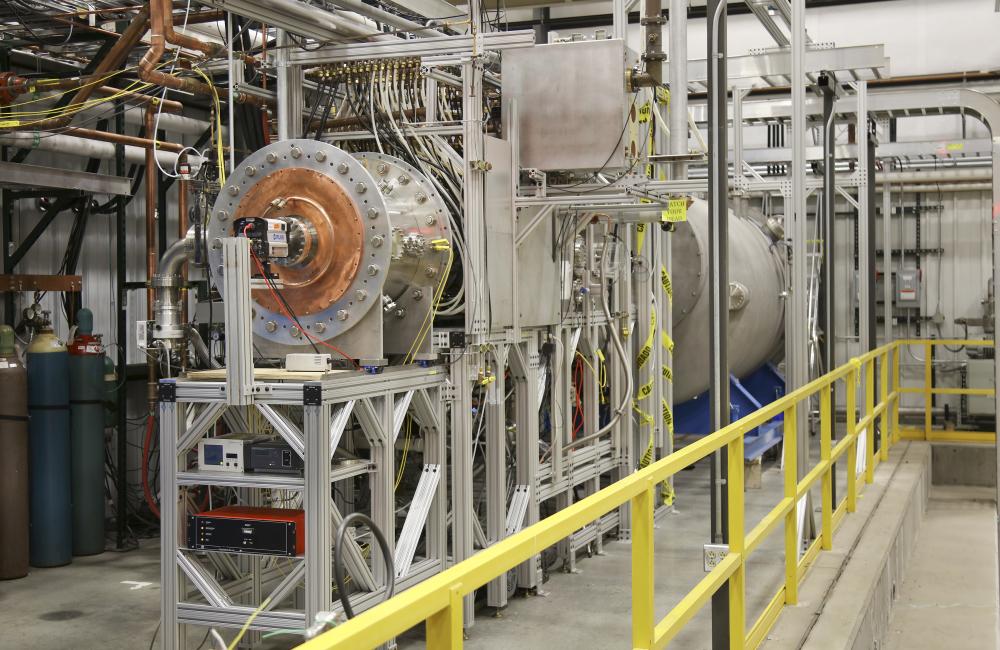The search for materials that can withstand the extreme environment inside advanced fusion research facilities and fusion power reactors is becoming more intense.
A focal point for this search is ORNL’s Material Plasma Exposure Experiment. At the heart of the experiment is a device that enables scientists to study the characteristics of both fusion plasma and materials that have been exposed to the plasma.
MPEX will likely test some of the materials used at ITER, the large-scale fusion reactor experiment under construction in France. But its primary purpose is to help to develop materials for devices beyond ITER—experimental facilities that will complement ITER, as well as the first generation of experimental fusion power reactors. ORNL is the U.S. headquarters for ITER.
“Developing materials for a fusion reactor is like developing a heat shield for the space shuttle,” says the MPEX program manager, Juergen Rapp. “However, the heat fluxes encountered by a reentry vehicle are nothing in comparison to the fluxes materials will experience inside a fusion reactor.”
Adding to the challenge is the fact that these materials will be constantly exposed to fusion plasmas reaching 10,000 to 100,000 degrees Kelvin (roughly 18,000 to 180,000 degrees Fahrenheit) that are made up of high-energy neutrons, ions and electrons that damage and degrade materials.
“These are the sorts of conditions you would experience on the surface of the sun,” Rapp says.
Material insights
The plan is for MPEX to test materials that have been developed by the laboratory’s Materials Science and Technologies Division.
“Then, depending on whether we want to study the effects of plasma or neutrons, the materials will be tested at the MPEX, or if we want to study the effect of neutrons, we’ll first send them to ORNL’s High Flux Isotope Reactor where they will be exposed to high neutron fluxes,” Rapp explains. “Later they can be transferred to the MPEX to expose them to plasmas similar to those they would encounter in a fusion reactor.”
The key attribute for a candidate material is the ability to resist surface erosion and the introduction of defects deeper within the material, caused by heat flux and high-energy particles.
Rapp describes heat flux erosion as being similar to billiard balls raining down onto a surface covered with more billiard balls. Sooner or later, some of the balls on the surface get knocked loose, making the neighboring balls more susceptible to being displaced and threatening the integrity of the material.
“It’s similar to the erosion you see in the landscape caused by wind and rain,” Rapp says. “But in our case it’s caused by ions and electrons.”
High-energy neutrons introduce similar defects deeper in the material, and ions not only erode material but also penetrate deeper into it, causing pressure that diffuses through the material and creates microstructural damage. This damage appears as blisters or hairs on the surface of the material.
A work in progress
As the word “experiment” in its name implies, ORNL’s MPEX is a work in progress. The current facility, dubbed proto-MPEX, is designed to test materials using a powerful plasma source—but only in brief bursts.
“The pulses are very short,” Rapp says, “but the source already produces powerful fluxes. When we build the more powerful MPEX facility, we’ll run the source 24 hours a day, seven days a week, for maybe two weeks at a time to expose materials to the plasma and see how they hold up. The MPEX source will be more intense, but the physics will be the same.
“After MPEX, we hope to pursue the Fusion Nuclear Science Facility. This facility will work in parallel with ITER. So while ITER studies the physics of fusion plasma, FNSF will study the technology needed to harness that power.”
The idea is that knowledge gained from ITER and FNSF, combined with the advanced material insights provided by facilities like proto-MPEX and MPEX, should provide the knowledge the research community will need to build a fusion power reactor—bringing practical fusion power generation that much closer to reality.



